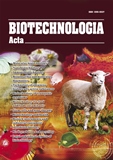ISSN 2410-7751 (Print)
ISSN 2410-776X (Online)

Biotechnologia Acta Т. 17, No. 2 , 2024
P. 57-58, Bibliography 7, Engl.
UDC::661.28: 577.161.3: 546.76: 577.12
DOI: https://doi.org/10.15407/biotech17.02.057
COMBINED EFFECT OF ETHYLTHIOSULFАNYLATE AND VITAMIN E ON THE ENZYMATIC ACTIVITY OF AMINOTRANSFERASES IN RAT BLOOD PLASMA UNDER THE TOXIC EFFECT OF Cr(VI)
B.I. Kotyk
Institute of Animal Biology NAAS, Lviv, Ukraine
Aim. The aim of our study was to investigate the effect of ethylthiosulfаnylate (ETS) and vitamin E on the enzymatic activity of blood plasma aspartate aminotransferase (AST) and alanine aminotransferase (ALT) of rats exposed to Cr(VI).
Methods. The study was performed on male Wistar rats divided into 6 groups of 5 animals each. The animals were administrated with: group I (control) – physiological saline for 7 days; group III – 2.5 mg Cr(VI)/kg b.w. for 14 days; group II – oil for 14 days; group IV – vitamin E oil solution [20 mg/kg b.w.] for 14 days; group V – ETS oil solution [100 mg/kg b.w.] and vitamin E [20 mg/kg b.w.] for 14 days; group VI – ETS oil solution [100 mg/kg b.w.] and vitamin E [20 mg/kg b.w.] for 14 days, after which 2.5 mg Cr(VI)/kg b.w. for 14 days. We determined the activity of AST, ALT and de Ritis coefficient in blood plasma.
Results: The activity of AST, ALT significantly increased (by 40%, 122%) and de Ritis coefficient significantly decreased (by 37%) in the blood plasma of rats after 14 days of Cr(VI) toxicity. AST, ALT increased (by 24%, 61%) also after combined exposure to ETS and vitamin E by subsequent 14-day exposure to Cr(VI) in the blood plasma of rats.
Conclusion: Cr(VI)-induced stimulation of blood plasma AST and ALT was twofold lower after combined pretreatment with ETS and vitamin E.
Key words: Cr(VI), thiosulfonate, vitamin E, aminotransferases.
REFERENCES
1. Wang Y., Hao J., Zhang S., Li L., Wang R., Zhu Y., Liu Y., Liu, J. Inflammatory injury and mitophagy induced by Cr(VI) in chicken liver. Environmental Science and Pollution Research. 2020, 27(18):22980–22988. https://doi.org/10.1007/s11356-020-08544-3
2. Ma Y., Li S., Tang S., Ye S., Liang N., Liang Y., Xiao F. Clusterin protects against Cr(VI)-induced oxidative stress-associated hepatotoxicity by mediating the Akt-Keap1-Nrf2 signaling pathway. Environmental Science and Pollution Research. 2022, 29(34):52289–52301. https://doi.
org/10.1007/s11356-022-19118-w
3. Liubas, N., Iskra, R., Lubenets, V. Antioxidant defense system of rat liver under the inflence thiosulfonates esters. Studia Biologica. 2023, 17(2), 43–56. https://doi:10.30970/sbi.1702.709
4. Kotyk B.I., Iskra R.Ya., Merlavsky V.M. Features of the influence of S-ethyl-4-aminobenzene thio sulfonate on some biochemical parameters of rat blood under the condition of Cr(VI) intoxication. Studia Biologica. 2023, 17(1):49–60. https://doi.org/10.30970/sbi.1701.701
5. Hassan M., Abd-Elwahab W., Megahed R., Mohammed A. An Evaluation of Hepatotoxici ty, Nephrotoxicity, and Genotoxicity Induced by Acute Toxicity of Hexavalent Chromium and Comparison of the Possible Protective Role of Selenium and Vitamin E on These Effects. Ain
Shams Journal of Forensic Medicine and Clinical Toxicology. 2019, 33(2):48–58. https://doi.org/10.21608/ajfm.2019.36574
6. Ndeh F.J ., Ojong E.W., Akpan U.O., Ekeagba I.I. Serum Amino Transaminases Activities and De Ritis Ratio amongst Apparently Healthy Secretors and Non-Secretors of ABH Substances Dwelling in Uyo Urban, Akwa Ibom State, Nigeria. Asian Journal of Research and Reports in Hepatology. 2022, 4(1): 1–20.
7. Yang D., Lv Z., Zhang H., Liu B., Jiang H., Tan X., Lu J., Baiyun R., Zhang Z. Activation of the Nrf2 signaling pathway involving KLF9 plays a critical role in allicin resisti ng against arsenic trioxideinduced hepatotoxicity in rats. Biological trace element research. 2017, 176(1):192–200. https://doi.org/10.1007/s12011-016-0821-1
© Palladin Institute of Biochemistry of National Academy of Sciences of Ukraine, 2024

